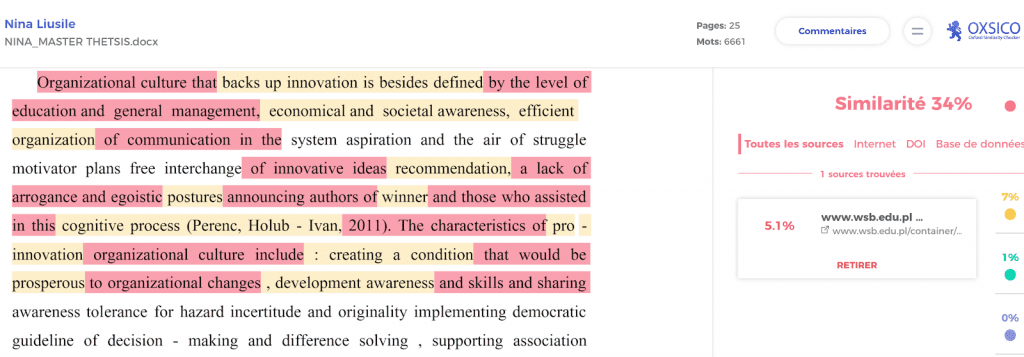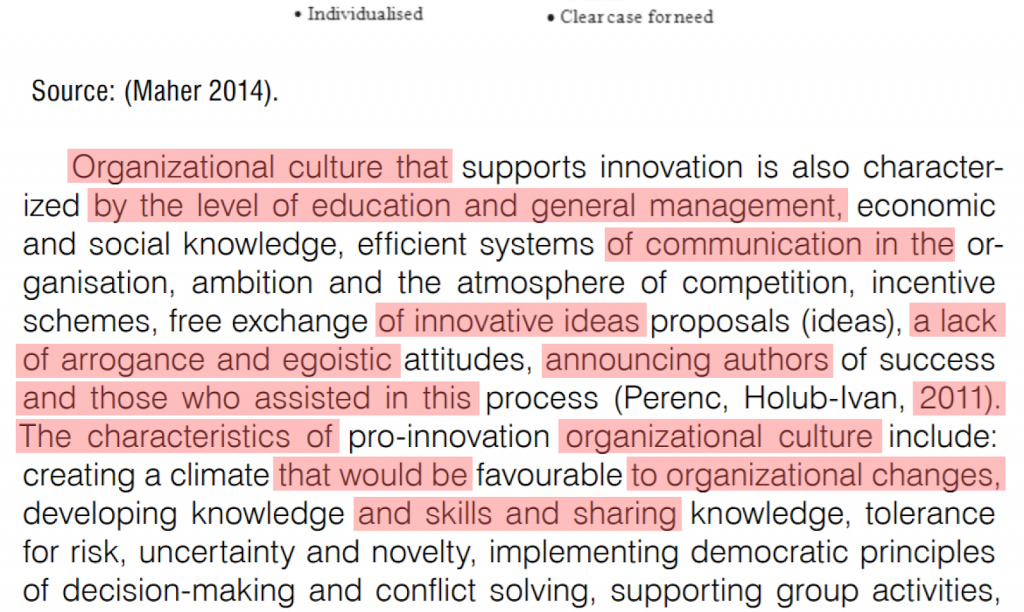Plagiarism detection software is becoming increasingly popular around the world. Such a thing is only natural. With rapidly improving AI tools, people generate tons of content. In order to detect plagiarism in various authors’ works, online plagiarism detection tools have to be improved and adapted to a rapidly changing environment 24/7. The best of those tools record significant increases in work volume and meet the needs of millions of users worldwide every single day.
The best plagiarism checker should be able not only to detect plagiarism accurately, but also have other important characteristics, such as rewrite and cheat detection, OCR capabilities, and the possibility to check scholarly content.
To identify the best plagiarism checker, we conducted the biggest in-depth analysis of most of the available plagiarism checkers on the market. We uploaded a test file to all the checkers, which was prepared in order to carry out different tests.
| Conclusion Our in-depth research shows that PLAG plagiarism checker is the best plagiarism checker on the market in 2023. It is able to detect paraphrased plagiarism as well as scholarly content, provides a clear report, and does not store papers in a database. |
Summarized rating of plagiarism checkers
| Plagiarism checker | Rating |
|---|---|
| Plag | [rating stars=”4.79″] |
| Oxsico | [rating stars=”4.30″] |
| Copyleaks | [rating stars=”3.19″] |
| Plagium | [rating stars=”3.125″] |
| Ithenticate / Turnitin / Scribbr | [rating stars=”2.9″] |
| Plagiarism checker | Rating |
|---|---|
| Quillbot | [rating stars=”2.51″] |
| PlagAware | [rating stars=”2.45″] |
| Plagscan | [rating stars=”2.36″] |
| Copyscape | [rating stars=”2.35″] |
| Grammarly | [rating stars=”2.15″] |
| Plagiarism checker | Rating |
|---|---|
| Plagiat.pl | [rating stars=”2.02″] |
| Compilatio | [rating stars=”1.89″] |
| Viper | [rating stars=”1.66″] |
| Smallseotools | [rating stars=”1.57″] |
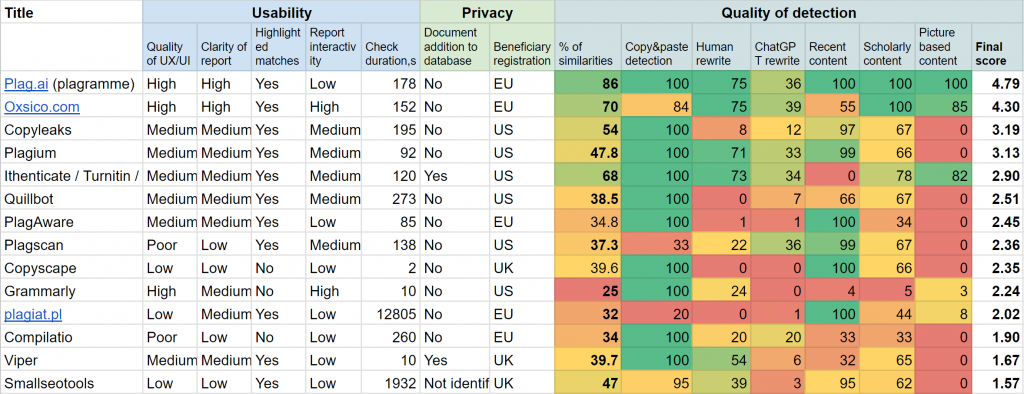
Methodology of research
We picked nine criteria to determine which plagiarism checker would be the best choice. Those criteria include:
Quality of detection
- Copy&Paste detection
- Rewrite detection (human & AI)
- Detection of different languages
- Real-time detection
- Detection of scholarly content
- Detection of picture-based content
Usability
- Quality of UX/UI
- Clarity of report
- Highlighted matches
- Report interactivity
- Check duration
Trustworthiness
- Privacy and security of user data
- Affiliation with paper mills
- Possibility to try free of charge
- Country of registration
In our test file, we included fully copied paragraphs from Wikipedia, the exact same (but paraphrased) paragraphs, also same paragraphs rewritten by ChatGPT, excerpts with texts of different languages, some scholarly content, and picture-based scholarly content. Without further ado, let‘s get straight to our list!
PLAG review
[rating stars=”4.79″]
“Identified more plagiarism than any other plagiarism checker”
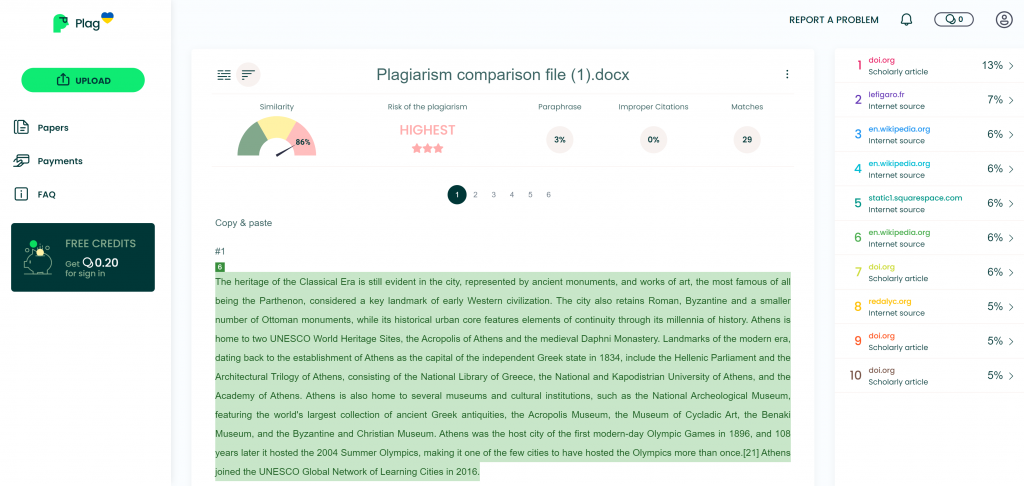
Pros
- Clear UX/UI & plagiarism report
- Rapid verification
- Does not store or sell user documents
- Detected the most plagiarism
- Detects picture-based sources
- Detects scholarly content
- Free verification
Cons
- Low report interactivity
- Quality comes at a price
How does PLAG compare with other plagiarism checkers
| All similarities | Copy & Paste | Real-time | Rewrite | Sources | ||
| Human | ChatGPT | Scholarly | Picture based | |||
| ★★★★★ | ★★★★★ | ★★★★★ | ★★★★★ | ★★★★★ | ★★★★★ | ★★★★★ |
Quality of plagiarism detection
PLAG performed the best in detecting various types of plagiarism, such as copy&paste and paraphrasing.
PLAG also was capable to detect scholarly content and texts from picture-based sources. The “picture” test, as we call it, was the hardest one and PLAG was one of only three plagiarism checkers who passed it.
ChatGPT rewrite detection scored 36 out of 100 but still, it was the highest result among other plagiarism checkers.
Usability
PLAG scored high in the usability test, however, the score was not the highest.
PLAG has developed good UX/UI. The report is clear to understand and to work with, but there is a low level of interactivity with the report – no possibility to eliminate sources or make comments.
The document was checked in 2min 58s, which is a moderate result.
PLAG also offers additional services such as document editing, proofreading, and plagiarism removal service, that are useful to students. Our total paid sum for testing with PLAG came at 18,85 euros. Not the best deal price-wise. However, in our research, we haven‘t found any other tool, that could match the quality of this plag checker.
Trustworthiness
PLAG is registered in the EU and it explicitly stated in their privacy policy that they do not include user documents in their comparative database, nor sell papers.
A very good thing about PLAG is that, unlike most plagiarism checkers, it allows checking documents free of charge. This is a good way to test the service prior to paying money. However, the free option gives only a limited amount of scores. The detailed report is a paid option.
Report of the plagiarism check
Oxsico review
[rating stars=”4.30″]
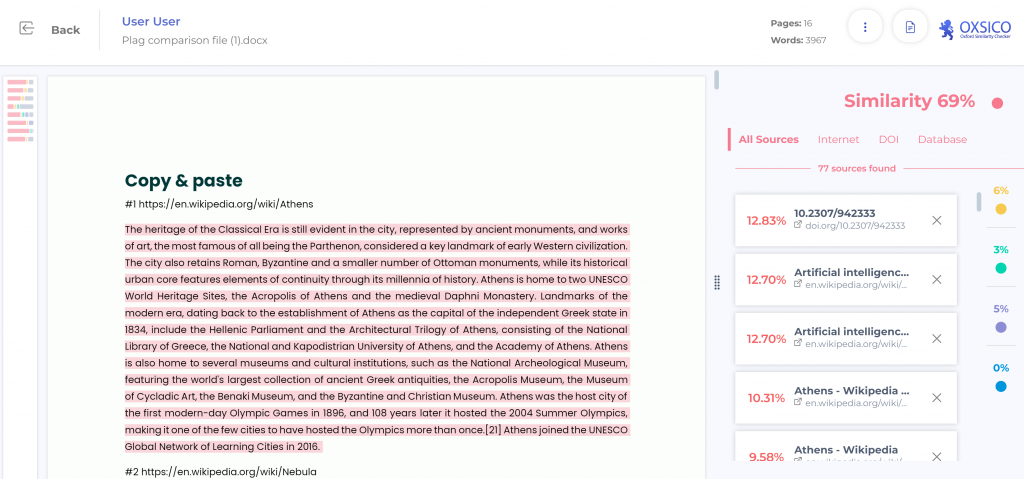
Pros
- Clear UX/UI & plagiarism report
- Rapid verification
- Detects picture-based sources
- Detects scholarly content
- High report interactivity
- Officially used by universities
- Text layout is kept intact in the online tool
Cons
- Only paid options
- Optimized for universities
How does Oxsico compare with other plagiarism checkers
| All similarities | Copy & Paste | Real-time | Rewrite | Sources | ||
| Human | ChatGPT | Scholarly | Picture based | |||
| ★★★★☆ | ★★★★☆ | ★★★☆☆ | ★★★★★ | ★★★★★ | ★★★★★ | ★★★★☆ |
Quality of detection
Oxsico was able to detect most of the plagiarism, however, it performed not so well in the detection of sources that recently appeared.
Oxsico detected plagiarism from scholarly and picture-based sources. Detection of ChatGPT rewrites outperformed all other plagiarism checkers.
Usability
Oxsico has a superb UX/UI. The report is very clear and interactive. The report allows you to exclude irrelevant sources.
Oxsico also shows paraphrasing, citations, and cheat instances. It took 2 min and 32 seconds to check the document. Oxsico outcompeted other plagiarism checkers with its usability.
Trustworthiness
Oxsico is registered in the EU. It gets trust by working with the universities. Oxsico allows you to store or not store uploaded documents in your repository.
Oxsico explicitly stated in their privacy policy that they do not include user documents in their comparative database, nor sell papers.
Copyleaks review
[rating stars=”3.19″]
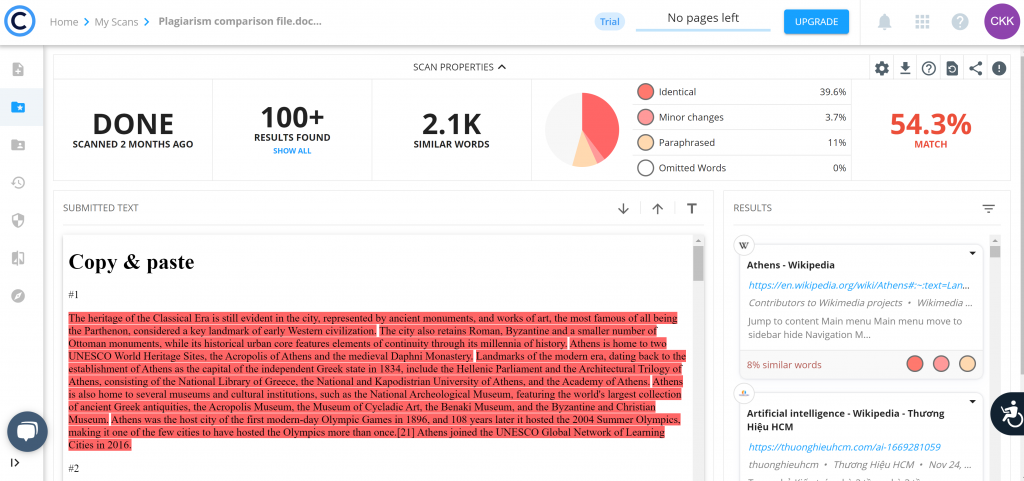
Pros
- Clear report
- Rapid verification
- Interactive report
Cons
- Poor detection of rewrites
- Did not detect picture-based sources
- Unclear data protection policy
How does Copyleaks compare with other plagiarism checkers
| All similarities | Copy & Paste | Real-time | Rewrite | Sources | ||
| Human | ChatGPT | Scholarly | Picture based | |||
| ★★★☆☆ | ★★★★★ | ★★★★★ | ★☆☆☆☆ | ★★☆☆☆ | ★★★☆☆ | ☆☆☆☆☆ |
Quality of detection
Copyleaks performed relatively poorly with different source types. It was good to detect Copy & Paste plagiarism but didn’t perform well with both rewrite tests.
Copyleaks was not able to detect picture-based sources and detection of scholarly content was limited.
Usability
Copyleaks online report is interactive. It is possible to exclude sources and also compare the original document with the source side by side.
Still, the report is quite difficult to read as they highlight all the sources with the same color.
The online report did not maintain the layout of the original file, and this makes it a bit more challenging to work with a tool.
Trustworthiness
Copyleaks are registered in the US and clearly state that they “will never steal your work.” Still, to remove uploaded documents, users need to contact them.
Plagium review
[rating stars=”3.125″]
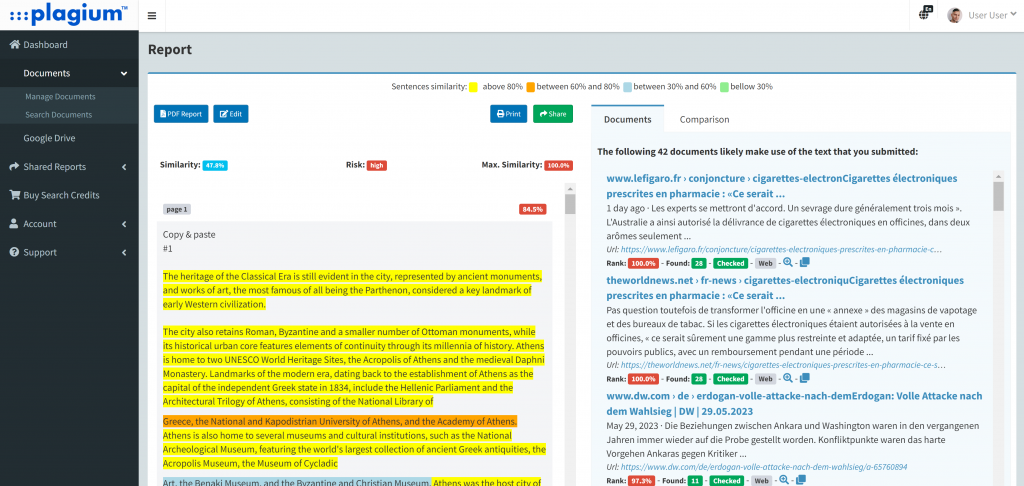
Pros
- Rapid verification
- Does not store or sell user documents
Cons
- Dated UX/UI, lack of clarity
- Low report interactivity
- Did not detect picture-based sources
- No free options
How does Plagium compare with other plagiarism checkers
| All similarities | Copy & Paste | Real-time | Rewrite | Sources | ||
| Human | ChatGPT | Scholarly | Picture based | |||
| ★★★☆☆ | ★★★★★ | ★★★★★ | ★★★★★ | ★★★★★ | ★★★☆☆ | ☆☆☆☆☆ |
Quality of detection
Overall Plagium detection score was mediocre. Although Plagium showed good results in detecting copy&paste plagiarism and rewrites, it was not so good at the detection of scholarly sources. This makes this tool less useful for students.
Plagium scored zero on the detection of picture-based sources.
Usability
It seems that Plagium has a sentence-based approach to identifying plagiarism. This might help to deliver faster results (the report came just after 1 min 32 s), but it prevents Plagium from delivering the detailed report.
It was not possible to see which words of the sentence were rewritten. It was also not possible to see how much of the text was taken from one source and which sentences belong to that source.
Trustworthiness
Plagium seems to be a trustworthy service. It is registered in the US and it seems that they are not affiliated with any paper mill.
Plagium does not offer a free trial, so it is not possible to check the service without risking your money.
Ithenticate / Turnitin / Scribbr review
[rating stars=”2.9″]
| Acknowledgment Ithenticate and Turnitin are different trademarks of the same plagiarism checker, belonging to the same company. Scribbr uses Turnitin for their checks. Further, in comparison, we will use Turnitin’s name. |
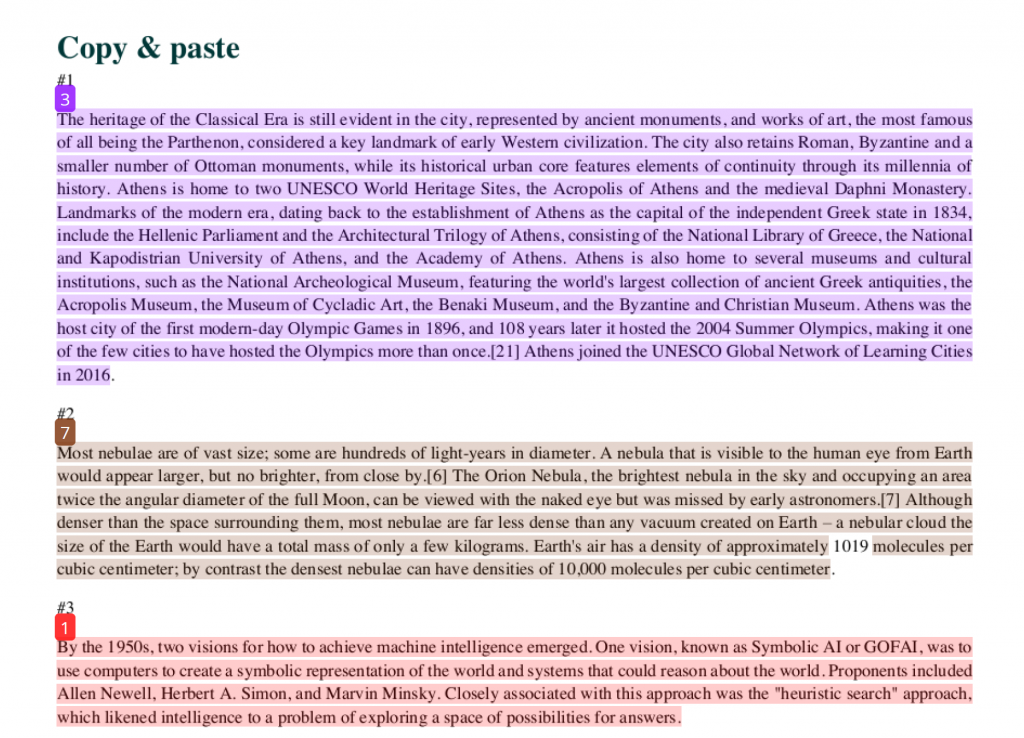
Pros
- Rapid verification
- Clear report
- Some report interactivity
- Detect scholarly content
Cons
- Expensive
- Turnitin includes papers in the database
- Did not detect recent sources
- No free options
How does Turnitin compare with other plagiarism checkers
| All similarities | Copy & Paste | Real-time | Rewrite | Sources | ||
| Human | ChatGPT | Scholarly | Picture based | |||
| ★★★★☆ | ★★★★★ | ☆☆☆☆☆ | ★★★★★ | ★★★★★ | ★★★★☆ | ★★★★☆ |
Quality of detection
Turnitin performed well in the detection of various sources. It is one of thee plagiarism checkers that detected picture-based sources. Turnitin is also good with rewrites and scholarly sources, making it useful for academic uses.
Unfortunately, Turnitin was not able to detect recently published sources. This makes it possible for Turnitin to fail on high-turnover tasks, such as homework or essays.
Usability
It is not possible to use Turnitin directly, so you should intermediary such as Scribbr. Turnitin report has some elements of interactivity. It is possible to exclude sources.
The lack of a report is that it is provided as an image. It is not possible to click and copy text or perform a search, making it complicated to work with the report.
Trustworthiness
Using Turnitin via intermediaries such as Scribbr increases the risk of your paper being leaked or stored. Moreover, Turnitin in their rules explicitly states that they include uploaded documents to their comparative database. For this reason, we reduced Turnitin’s overall score by 1 point.
Quillbot review
[rating stars=”2.51″]
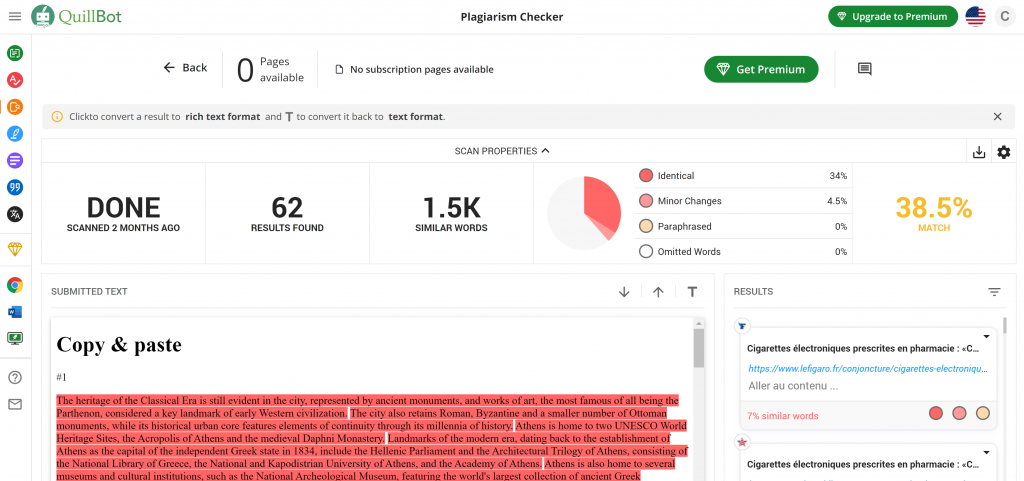
Pros
- Clear report
- Rapid verification
- Interactive report
Cons
- Poor detection of rewrites
- Did not detect picture-based sources
- Unclear data protection policy
How does Quillbot compare with other plagiarism checkers
| All similarities | Copy & Paste | Real-time | Rewrite | Sources | ||
| Human | ChatGPT | Scholarly | Picture based | |||
| ★★☆☆☆ | ★★★★★ | ★★★★★ | ☆☆☆☆☆ | ★☆☆☆☆ | ★★★☆☆ | ☆☆☆☆☆ |
Quality of detection
Quillbot performed relatively poorly with different source types. It was only good in detecting Copy & Paste plagiarism but didn’t perform well with both rewrite tests.
Quillbot was not able to detect picture-based sources and detection of scholarly content was limited.
Interesting to mention that despite the fact that Quillbot is powered by Copyleaks, the results were different. It was expected to get the same results, but Quillbot performed poorer than Copyscape.
Usability
Quilbot shares the same UI as Copyleaks. Their online report is interactive. It is possible to exclude sources and also compare the original document with the source side by side.
Still, as we mentioned in the Copyleaks review, the report is quite difficult to read as they highlight all the sources with the same color.
The online report did not maintain the layout of the original file, and this makes it a bit more challenging to work with a tool.
Trustworthiness
Quillbot is an intermediary, so it adds additional risks for documents to be accessed or leaked.
PlagScan review
[rating stars=”2.36″]
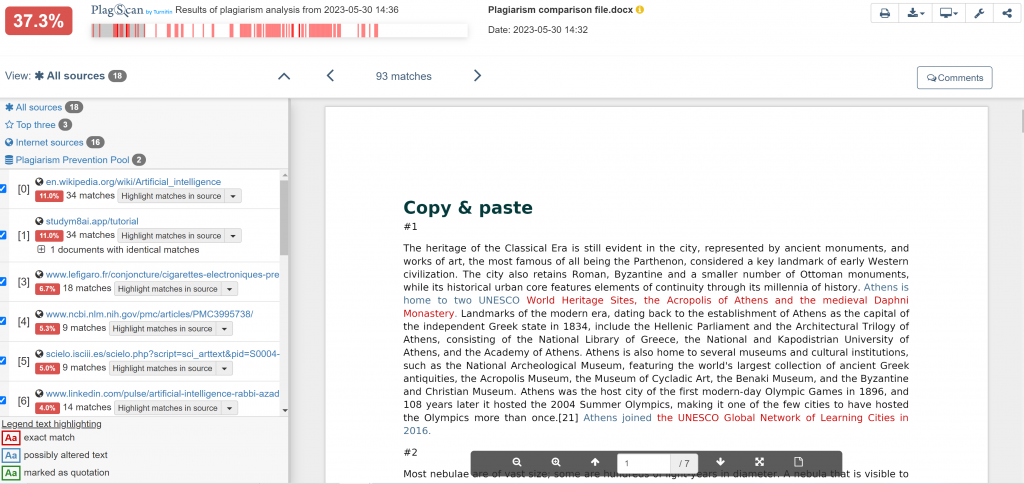
Pros
- Rapid verification
- Interactive report
- Detects real-time sources
- Detects ChatGPT rewrite
Cons
- Outdated UX/UI
- Low clarity of the report
- Poor detection of human rewrite
- Did not detect copy & paste plagiarism
- Did not detect picture-based sources
How does Plagscan compare with other plagiarism checkers
| All similarities | Copy & Paste | Real-time | Rewrite | Sources | ||
| Human | ChatGPT | Scholarly | Picture based | |||
| ★★☆☆☆ | ★★☆☆☆ | ★★★★★ | ★☆☆☆☆ | ★★★★★ | ★★★☆☆ | ☆☆☆☆☆ |
Quality of detection
Plagscan performed relatively poorly with different source types. It was good in detecting real-time and ChatGPT-rewritten content. On the other hand, Plagscan didn’t perform well with human-rewritten content.
Plagscan was not able to detect picture-based sources. Detection of scholarly content and even copy & paste content was limited.
Usability
Plagscan has poor UX/UI making it not comfortable to use. Matches are very hard to notice. Plagscan shows changed words but their detection of rewrites is poor.
It is possible to exclude sources and also compare the original document with the source side by side.
The online report did not maintain the layout of the original file, and this makes it a bit more challenging and unpleasant to work with a tool.
Trustworthiness
Plagscan is a trustworthy EU-based company. On the other hand, it was recently acquired by Turnitin so it is unclear what the document policy Plagscan will follow from now on.
PlagAware review
[rating stars=”2.45″]
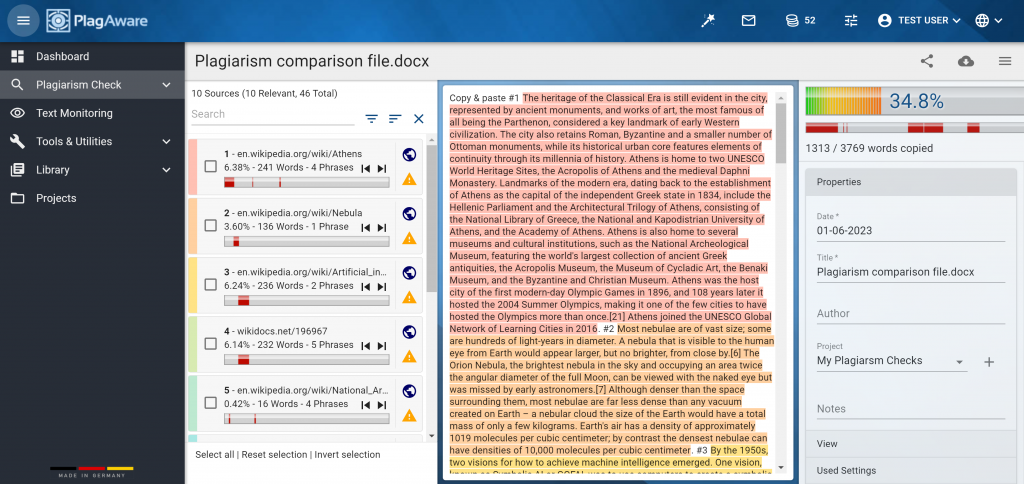
Pros
- Rapid verification
- Clear and interactive report
- Detects real-time sources
Cons
- Dated UX/UI
- Poor detection of rewrites
- Poor detection of scholarly content
- Did not detect picture-based sources
How does PlagAware compare with other plagiarism checkers
| All similarities | Copy & Paste | Real-time | Rewrite | Sources | ||
| Human | ChatGPT | Scholarly | Picture based | |||
| ★★☆☆☆ | ★★★★★ | ★★★★★ | ☆☆☆☆☆ | ☆☆☆☆☆ | ★★☆☆☆ | ☆☆☆☆☆ |
Quality of detection
PlagAware was good at detecting copy & paste plagiarism and sources that were added recently. Unfortunately, it did not perform well with both human and AI rewritten tests.
PlagAware also performed poorly with the detection of scholarly articles. Only third of sources were detected, making it quite useless for academic papers.
PlagAware was not able to detect picture-based sources.
Usability
The report of PlagAware is quite clear and easy to comprehend. The report is easy to navigate as it uses different colors for sources. PlagAware has a tool that shows which parts of the document are plagiarized.
However, the original format of the document is not preserved, making it a bit complicated to work with the report.
Trustworthiness
PlagAware is an EU-based company. It seems that they do not store or sell the papers. Their website contains the phone number and contact form.
Grammarly review
[rating stars=”2.15″]
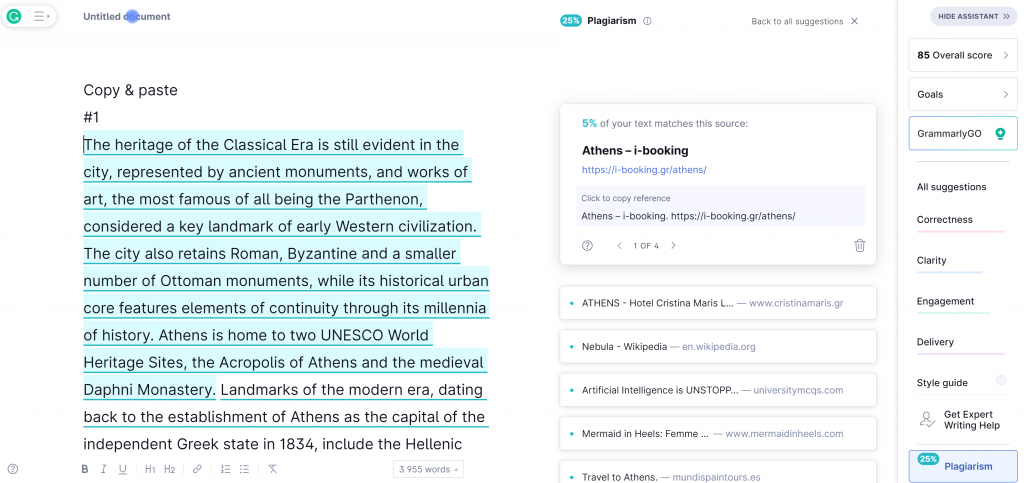
Pros
- Excellent UX/UI
- Rapid verification
- Clear and interactive report
Cons
- Poor quality of detection
- Poor detection of rewrites, especially AI rewrite
- Did not detect picture-based sources
- Did not detect scholarly content
How does Grammarly compare with other plagiarism checkers
| All similarities | Copy & Paste | Real-time | Rewrite | Sources | ||
| Human | ChatGPT | Scholarly | Picture based | |||
| ★☆☆☆☆ | ★★★★★ | ☆☆☆☆☆ | ★★☆☆☆ | ☆☆☆☆☆ | ☆☆☆☆☆ | ☆☆☆☆☆ |
Quality of detection
Grammarly was able to detect copy & paste plagiarism and did this perfectly. However, it did not detect any other sources, including scholarly, picture-based, and real-time, making it useless for academic needs.
Grammarly showed some capabilities at detecting human rewrites, but these were weak compared to its peers.
Usability
Grammarly has one of the best UX/UI. It is possible to exclude sources, and the report is very interactive. However, all of this comes at a price. One-month subscription cost 30$.
All the matches are highlighted in the same color, making it quite difficult to see the boundaries of various sources. It is possible to see how much text is used from a particular source, but this information is covered in cards.
In addition, there is a 100,000-character limit for both the monthly plan and the yearly plan ($12 per month).
Trustworthiness
It seems that Grammarly is a trustworthy company and does not store or sell user documents. It has a lot of reviews and trust among customers.
Plagiat.pl review
[rating stars=”2.02″]
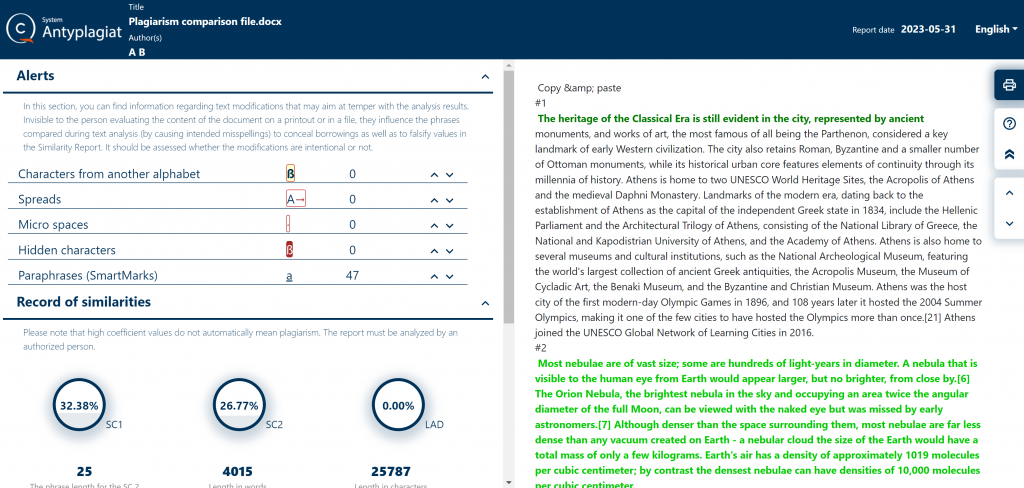
Pros
- Real-time detection
Cons
- Poor UX/UI
- Not interactive report
- Limited detection of copy & paste plagiarism
- Did not detect rewrites
- Did not detect picture-based sources
- Limited detection of scholarly content
- Extremely long verification time
How does Plagiat.pl compare with other plagiarism checkers
| All similarities | Copy & Paste | Real-time | Rewrite | Sources | ||
| Human | ChatGPT | Scholarly | Picture based | |||
| ★★☆☆☆ | ★☆☆☆☆ | ★★★★★ | ☆☆☆☆☆ | ☆☆☆☆☆ | ★★☆☆☆ | ☆☆☆☆☆ |
Quality of detection
Plagiat.pl performed well detecting recently appeared content. However, this was the only test that passed well.
Plagiat.pl did not detect any rewrites, nor human, nor AI. Surprisingly, copy&paste detection was limited, detecting only 20% of verbatim content.
Plagiat.pl also did not detect any picture-based sources, and their scholarly content detection was limited.
Usability
Plagiat.pl has a simple yet understandable plagiarism report. However, all the sources are marked in one color, making it difficult to analyze the report. The report is not interactive. In addition, it does not preserve the original file format.
It took extremely long to get the verification result. The report arrived after 3h 33min, which was the worst result among other plagiarism checkers.
Trustworthiness
It seems that Plagiat.pl is a trustworthy company and does not store or sell user documents. Plagiat.pl has some institutional clients in Eastern Europe.
Compilatio review
[rating stars=”1.89″]
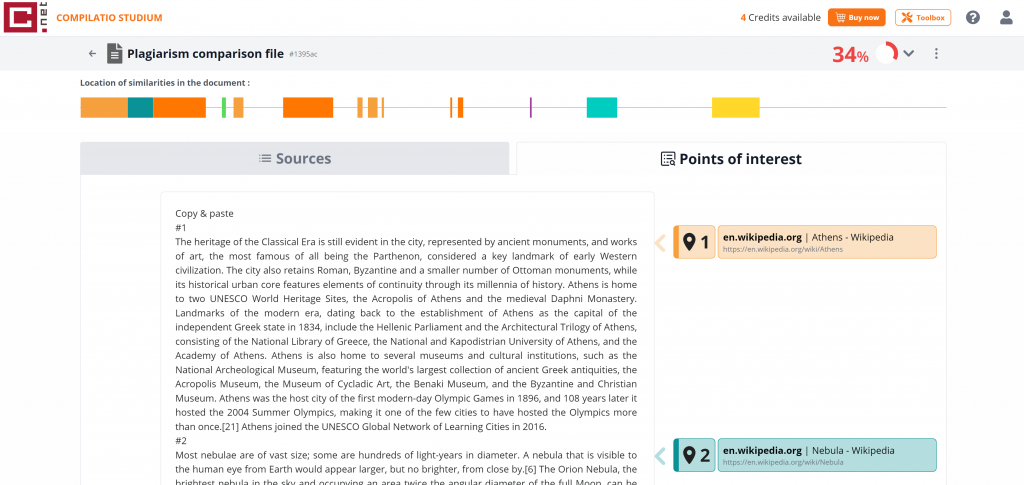
Pros
- Rapid verification
Cons
- Poor UX/UI, not interactive report
- Poor rewrite detection (especially human)
- Did not detect picture-based sources
- Limited detection of scholarly content
- Limited detection of recent content
How does Compilatio compare with other plagiarism checkers
| All similarities | Copy & Paste | Real-time | Rewrite | Sources | ||
| Human | ChatGPT | Scholarly | Picture based | |||
| ★★☆☆☆ | ★★★★★ | ★★☆☆☆ | ★☆☆☆☆ | ★★★☆☆ | ★★☆☆☆ | ☆☆☆☆☆ |
Quality of detection
Compilatio performed well in detecting Copy&Paste plagiarism. However, this was the only test that passed well.
Compilatio has limited success in detecting rewrites. The human rewrite was harder to detect than ChatGPT rewrite.
Compilatio had limited success in detecting recent content and scholarly article sources and zero success in detecting picture-based content. Compilatio could be somewhat useful in detecting plagiarism for blogs but will have limited usability for academic needs.
Usability
Compilatio has a useful tool showing which parts of the documents contain plagiarized elements. However, the generated report does not highlight similar parts, making the report virtually unusable.
The report shows sources, but it is completely not clear where similarity starts and where ends. In addition, it does not preserve the original document layout.
Trustworthiness
Compilatio is quite an old company, having some institutional clients in France. It seems that it is a trustworthy company and does not store or sell user documents.
Viper review
[rating stars=”1.66″]
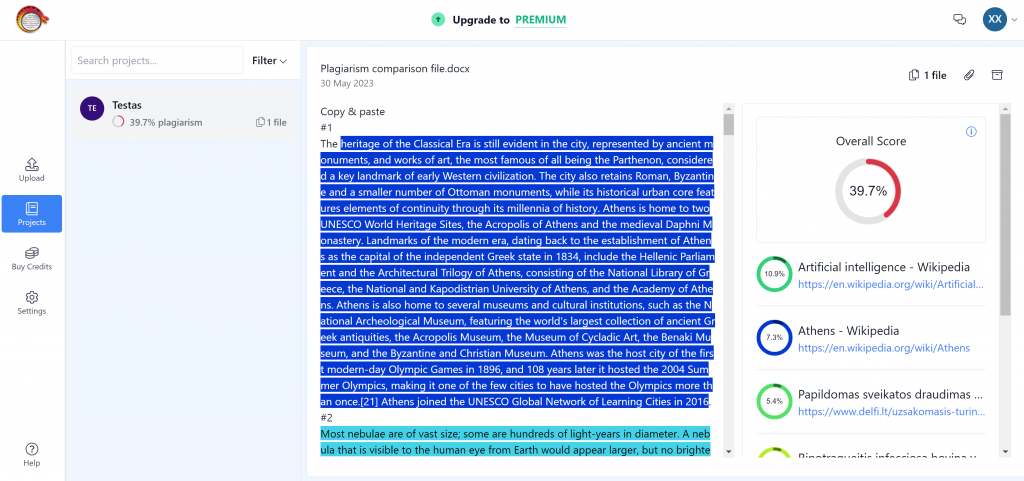
Pros
- Clear report
- Very fast verification
- Good detection of human rewrite
Cons
- The report is not interactive
- Poor detection of AI rewrite
- Did not detect picture-based sources
- Limited detection of scholarly content
- Limited detection of recent content
How does Viper compare with other plagiarism checkers
| All similarities | Copy & Paste | Real-time | Rewrite | Sources | ||
| Human | ChatGPT | Scholarly | Picture based | |||
| ★★☆☆☆ | ★★★★★ | ★★☆☆☆ | ★★★★☆ | ★☆☆☆☆ | ★★★☆☆ | ☆☆☆☆☆ |
Quality of detection
Viper performed well in detecting Copy&Paste plagiarism. It also had some success in detecting human rewrites. However, the performance of the detection of AI-rewritten content was very poor.
Viper had limited success in detecting recent content and scholarly article sources. In addition, it has zero success in detecting picture-based content.
Usability
Viper has a clear report which makes it easy to understand it. However, the lack of interactivity makes working with the tool relatively complicated. It is not possible to exclude sources or see document comparison with the source.
Viper showed how much of the content was taken from a single source, and it had the best speed of verification. The verification took only 10 seconds to complete.
Trustworthiness
Viper is a UK-based company. It also owns an essay-writing service making it risky to upload papers. The company state that they do not sell documents if users use the paid version (prices start at $3.95 per 5,000 words). However, in case the free version is used, they publish the text on an external website as an example for other students just after three months.
There is always a risk that the company might also resell paid papers or use them in their writing process. Because of the affiliation with essay services, we reduced the overall score by 1 point.
Smallseotools review
[rating stars=”1.57″]
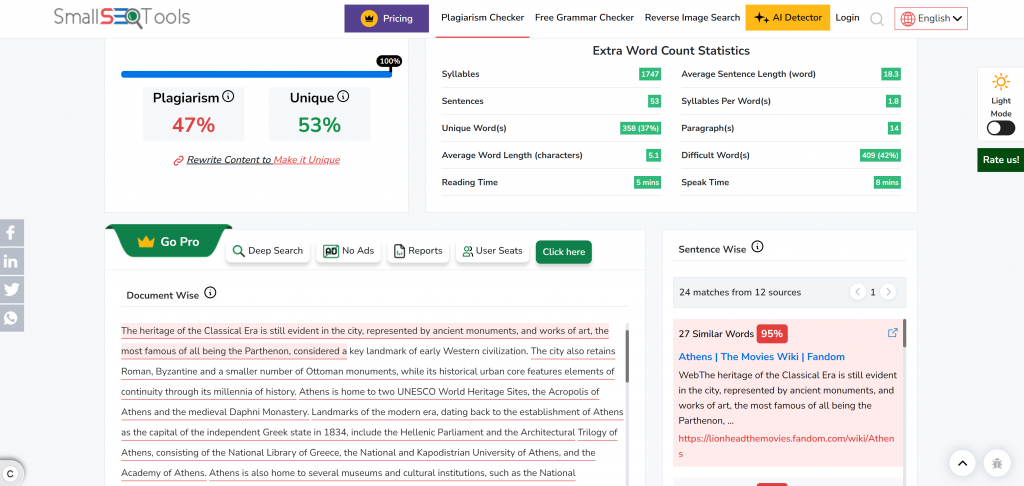
Pros
- Good detection of recent content
- Free report
Cons
- The report is not interactive
- Poor detection of rewrites (especially AI)
- Did not detect picture-based sources
- Limited coverage of scholarly content
- Slow verification
- 1000 words limit
- Heavy on ads
How does Smallseotools compare with other plagiarism checkers
| All similarities | Copy & Paste | Real-time | Rewrite | Sources | ||
| Human | ChatGPT | Scholarly | Picture based | |||
| ★★★☆☆ | ★★★★★ | ★★★★★ | ★★★☆☆ | ☆☆☆☆☆ | ★★★☆☆ | ☆☆☆☆☆ |
Quality of detection
Smallseotools performed well in detecting Copy&Paste plagiarism and recently appeared content. It also had some success in detecting human rewrites. However, the performance of the detection of AI-rewritten content was very poor.
Viper had limited success in detecting scholarly sources. In addition, it has zero success in detecting picture-based content.
Usability
Smallseotools offer a limited free version of plagiarism check which makes it a good option for those who are on a budget. The report lacks clarity as all the sources are single-colored. It is also not possible to exclude irrelevant sources from the plagiarism report.
Smalseotools have a limited number of words per check (1000 words). In addition, the verification takes much of the time. It took 32 minutes to check the file by parts.
Trustworthiness
It is unclear where the company behind Smallseotools is located and what their policy is towards the protection of user-uploaded documents.
Copyscape review
[rating stars=”2.35″]
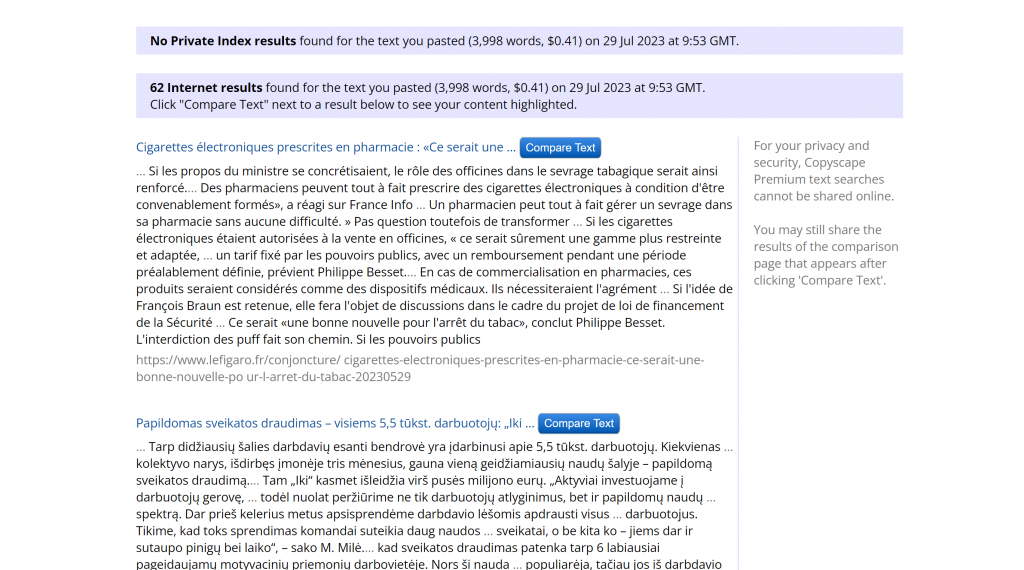
Pros
- Very fast
- Real-time detection
Cons
- The report is not interactive
- Did not detect rewrites
- Did not detect picture-based sources
- Limited coverage of scholarly content
How does Copyscape compare with other plagiarism checkers
| All similarities | Copy & Paste | Real-time | Rewrite | Sources | ||
| Human | ChatGPT | Scholarly | Picture based | |||
| ★★☆☆☆ | ★★★★★ | ★★★★★ | ☆☆☆☆☆ | ☆☆☆☆☆ | ★★★☆☆ | ☆☆☆☆☆ |
Quality of detection
In general, Copyscape performed well at detecting copy & paste plagiarism, including from recently published sources.
On the other hand, it performed very poorly at detecting rewrites. In fact, it didn’t detect any rewrites, making it of limited usability for students.
Surprisingly it had some limited detection of scholarly sources but failed to detect picture-based content.
Usability
Copyscape has a very simple UX/UI, but the report is hard to understand. It shows the copied parts of the text but does not show them in the document context. It could be ok to check small posts, but virtually unusable for checking student papers.
The document was checked extremely fast. It was the fastest plagiarism checker in our test.
Trustworthiness
Copyscape does not store or sell user documents. You have the possibility to create your private index, but that remains under your control.
*Please note that some of the tools for plagiarism checks that were mentioned in this table were not analyzed for various reasons. Scribbr uses the same plag-checking system as Turnitin, Unicheck is being closed at the time of writing and publication of this list, and we found no technical possibilities to test Ouriginal with our text sample.







